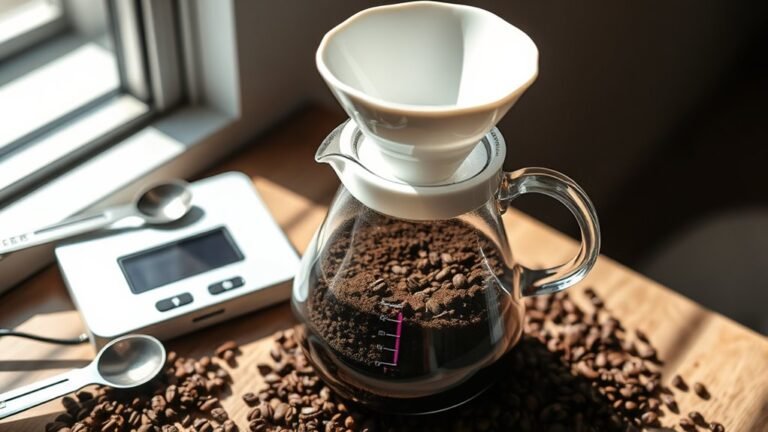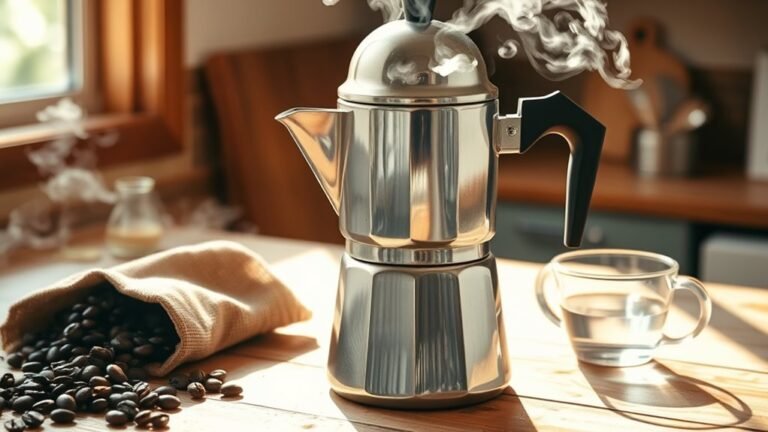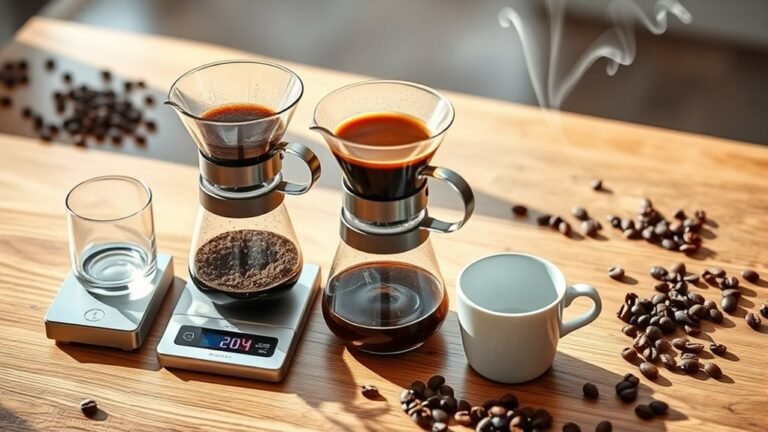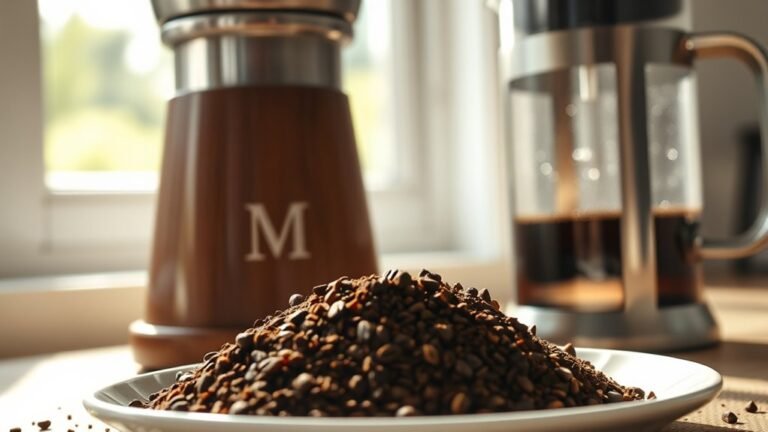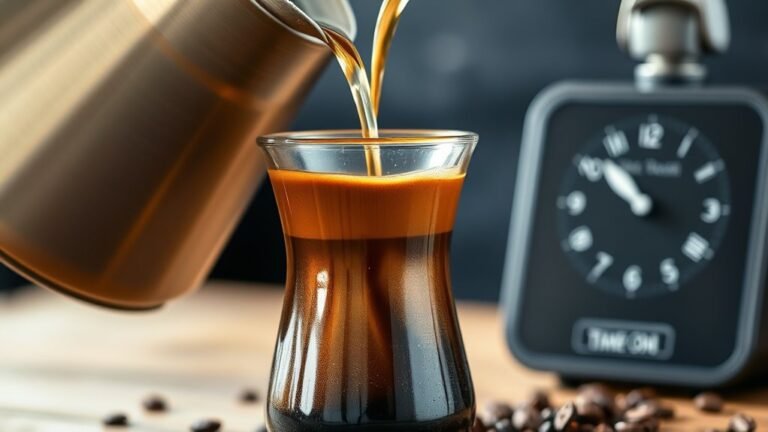The Ultimate Guide to French Press Coffee
To master French press coffee, start with single-origin, medium roasts for balanced flavor. Use a burr grinder to achieve a coarse, uniform grind that prevents over-extraction. Brew with water just off boil (195–205°F) for four minutes, then plunge slowly to avoid bitterness. Adjust coffee-to-water ratio and steep time to personalize strength. Clean the plunger assembly carefully after each use to preserve purity. Stick around to uncover advanced techniques for flavor infusion and precise temperature control.
Choosing the Perfect Coffee Beans for French Press
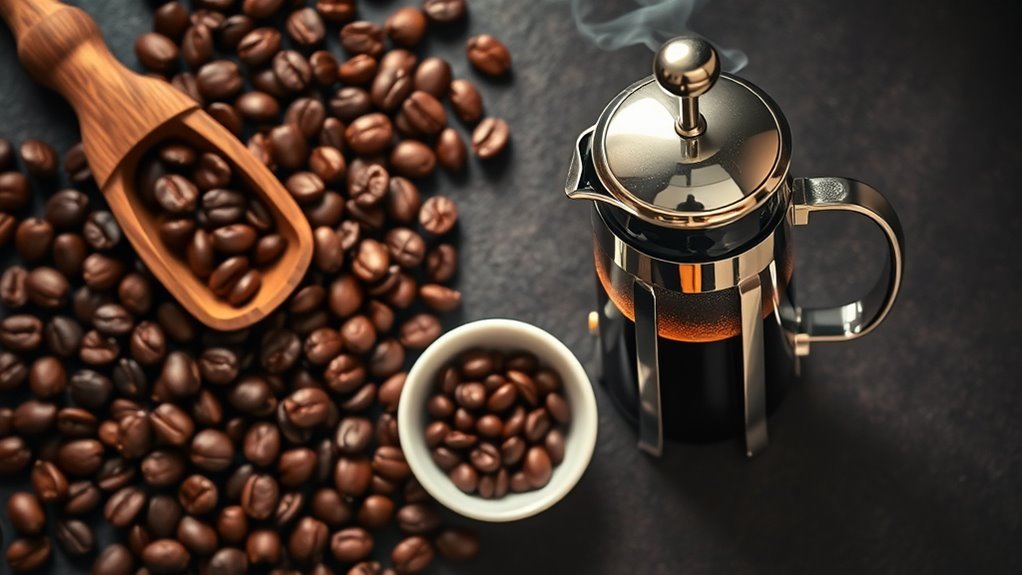
Although any coffee bean can technically be used in a French press, selecting beans with specific characteristics greatly enhances flavor extraction. You’ll want to start by considering bean origin; single-origin beans often provide distinct flavor profiles that shine through the immersion brewing method. Beans from regions like Ethiopia or Colombia offer bright acidity and fruity notes, which balance well with the full-bodied texture of the French press. Next, focus on roast level—medium to medium-dark roasts are ideal because they preserve nuanced flavors without becoming overly bitter or smoky. Lighter roasts may under-extract and taste sour, while darker roasts can dominate with excessive bitterness. By choosing beans with the right origin and roast level, you maintain control over your brew’s complexity and achieve a rich, satisfying cup that aligns with your desire for freedom in flavor exploration.
How to Grind Coffee for Optimal French Press Brewing
You’ll want to grind your coffee to a coarse, uniform size to prevent over-extraction and sediment in your French press. Burr grinders are ideal because they provide consistent particle size compared to blade grinders. Focus on steady, even grinding techniques to maintain uniformity, which guarantees balanced flavor extraction every time.
Grind Size Importance
The grind size plays a critical role in achieving the ideal extraction when brewing French press coffee. You need a coarse, consistent grind to maximize extraction efficiency while preserving the coffee’s nuanced flavors. Inconsistent grind uniformity causes uneven brewing, resulting in bitterness or weak taste. Too fine a grind clogs the mesh filter and over-extracts, while too coarse leaves under-extracted grounds.
| Grind Size | Extraction Efficiency | Brew Quality |
|---|---|---|
| Fine | Low | Over-extracted |
| Coarse | High | Balanced & clean |
| Very Coarse | Very Low | Under-extracted |
Selecting the right grind size empowers you to release full flavor freedom, ensuring your French press yields a rich, smooth cup every time.
Best Grinder Types
When aiming for the perfect coarse grind crucial for French press brewing, choosing the right grinder type is critical because it directly affects grind consistency and particle size distribution. Burr grinders, both flat and conical, excel here by crushing beans uniformly, allowing you to dial in coarse settings that prevent over-extraction and sediment in your cup. Their precise adjustment mechanisms guarantee you achieve repeatable grind size, preserving the full-bodied texture and flavor you want. Blade grinders, on the other hand, chop beans unevenly, producing a mix of fines and large particles that disrupt extraction balance and create bitterness. While blade grinders offer affordability, they limit your control and freedom to perfect your brew. For ideal French press results, burr grinders remain the superior choice, delivering consistent coarse grounds essential for a clean, rich extraction.
Grinding Tips for Consistency
Selecting a burr grinder sets the foundation, but maintaining consistent grind size requires careful attention during the grinding process itself. To achieve ideal grind uniformity and preserve grind freshness, you must calibrate your grinder precisely and grind only the amount needed immediately before brewing. Avoid overgrinding or excessive pauses, which can cause uneven particles and oxidation. Consistency in grind size guarantees even extraction and a balanced cup.
| Tip | Benefit |
|---|---|
| Use a burr grinder | Uniform particle size |
| Grind fresh per brew | Maximizes flavor retention |
| Adjust grind size finely | Tailors extraction rate |
| Grind consistently | Prevents channeling and bitterness |
Mastering these habits grants you true freedom in your French press brewing.
Step-by-Step French Press Brewing Process
You’ll start by using a coarse grind size to prevent over-extraction and sediment in your cup. Next, you’ll add hot water just off the boil and let the coffee steep for exactly four minutes to balance flavor and strength. Paying close attention to these variables guarantees a clean, robust brew every time.
Coffee Grind Size
Although grind size might seem like a minor detail, it plays a critical role in achieving the perfect extraction during French press brewing. You need a coarse grind to allow maximum water flow and prevent over-extraction, especially at your chosen brewing temperature (usually around 195°F–205°F). Too fine, and you risk a bitter, sludgy cup.
| Grind Size | Particle Size (mm) | Extraction Effect |
|---|---|---|
| Coarse | 0.8 – 1.0 | Balanced, clean, smooth |
| Medium-Coarse | 0.6 – 0.8 | Slightly bitter, over-extracted |
| Medium | 0.4 – 0.6 | Over-extracted, harsh |
| Fine | < 0.4 | Sludge, bitterness |
Matching grind size with brewing temperature maximizes your control over extraction precisely, giving you freedom to craft your perfect cup.
Steeping Time Tips
Because steeping time directly influences extraction, controlling it precisely is essential for achieving your desired flavor profile in French press coffee. Start by pouring water heated to about 195°F–205°F over your grounds, ensuring ideal temperature control to prevent under- or over-extraction. Employ consistent steeping techniques by timing your brew for exactly four minutes, a balanced duration that extracts oils and solubles without bitterness. You can adjust steeping time slightly—shorter for lighter, brighter notes; longer for fuller, robust flavors. To maintain freedom in flavor experimentation, use a timer and a thermometer, allowing you to replicate or tweak results with precision. Mastering these elements frees you to customize each brew, harnessing steeping time and temperature control as your tools for perfect French press coffee.
Adjusting Brew Time and Coffee-to-Water Ratio
Mastering French press coffee involves dialing in two critical variables: brew time and coffee-to-water ratio. To control extraction, start with a standard water ratio of 1:15—one gram of coffee per 15 grams of water. Adjusting this ratio will impact strength; increasing coffee or reducing water yields a bolder cup, while the reverse lightens it. Brew time directly influences flavor concentration and mouthfeel. A typical range is 4 to 5 minutes; extending beyond risks over-extraction and bitterness, shortening may under-extract and taste weak. Use a timer to maintain consistency. By experimenting with these parameters, you gain freedom to tailor your cup’s intensity and character precisely, ensuring each brew aligns with your personal preferences and desired coffee experience.
Tips for Achieving a Balanced and Flavorful Cup
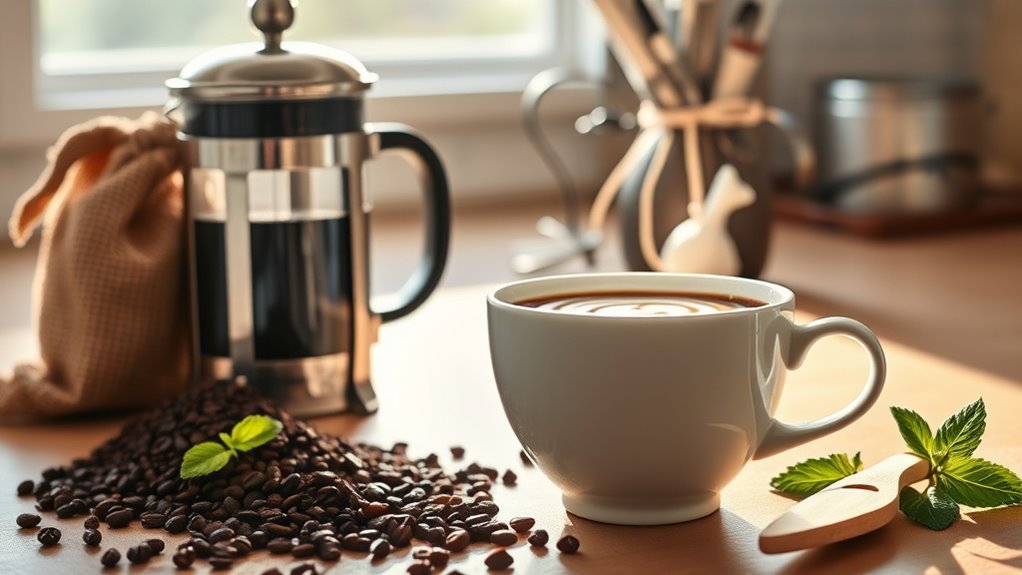
A balanced and flavorful French press cup hinges on controlling key variables beyond just brew time and coffee-to-water ratio. Master these elements to reveal your coffee’s full potential:
- Brewing Temperature: Maintain water between 195°F and 205°F; too hot extracts bitterness, too cool yields weak flavors.
- Water Quality: Use filtered or spring water to avoid impurities that dull taste and aroma.
- Grind Consistency: Opt for a coarse, uniform grind to prevent over-extraction and sediment in your cup.
- Plunging Technique: Press the plunger slowly and steadily to minimize agitation and avoid releasing unwanted bitterness.
Cleaning and Maintaining Your French Press
Although your French press may seem straightforward to clean, neglecting proper maintenance can lead to buildup that impairs both function and flavor. Start by disassembling the plunger components to access the mesh filter, spiral plate, and cross plate. Rinse all parts immediately after use with warm water to prevent oil residue from solidifying. Employ cleaning techniques such as using a soft brush or sponge with mild detergent to scrub the filter mesh gently, avoiding damage that compromises filtration. Regularly soak parts in a solution of water and white vinegar to dissolve mineral deposits. Dry everything thoroughly to prevent rust or mold. Maintenance tips also include periodically inspecting the plunger assembly for wear and replacing components as needed, ensuring your French press operates freely and delivers pure, untainted coffee essence.
Exploring Variations and Flavor Enhancements
Keeping your French press in ideal condition sets the stage for experimenting with various brewing techniques and flavor profiles. To reveal new dimensions in your cup, consider these precise methods:
- Flavor infusions: Add crushed cardamom pods or cinnamon sticks to your grounds before brewing for subtle aromatic complexity.
- Seasonal spices: Incorporate nutmeg or cloves during steeping to mirror seasonal moods with warmth and depth.
- Adjusting grind size: Finer grinds yield stronger extraction, while coarser grinds produce lighter, cleaner flavors—experiment to find your freedom.
- Water temperature manipulation: Slightly cooler water (around 90°C) preserves delicate notes; hotter water intensifies boldness.
Frequently Asked Questions
Can I Use Pre-Ground Coffee for French Press Brewing?
Using pre-ground coffee for your French press can feel like trying to catch lightning in a bottle—it’s tricky! The grind size is essential; it should be coarse to avoid over-extraction and bitterness. Pre-ground coffee often has a finer grind, which can disrupt the flavor profile you’re aiming for, resulting in a muddy cup. If you crave freedom in flavor, grinding fresh beans to the right coarseness gives you precise control and a richer, cleaner taste.
What Is the Best Water Temperature for French Press Coffee?
You’ll want to aim for water between 195°F and 205°F when brewing French press coffee. This temperature range optimizes extraction, ensuring balanced flavors without bitterness. Using high-quality water is essential since impurities can alter taste and aroma. Mastering this brewing technique gives you freedom to customize your cup’s strength and character. Just heat your water, let it sit briefly off the boil, then pour over your grounds for perfect infusion.
How Does Altitude Affect French Press Coffee Brewing?
Altitude impact plays a significant role in your French press brewing. Higher altitudes mean lower boiling points, so your water won’t reach the usual 212°F. To compensate, you’ll need brewing adjustments like increasing steeping time or slightly raising water temperature to extract ideal flavors. These tweaks help you overcome altitude’s effects, ensuring your coffee remains rich and balanced, giving you the freedom to enjoy a perfect cup no matter where you are.
Can I Make Iced Coffee Using a French Press?
You can definitely make iced coffee using a French press by exploring different iced coffee techniques. One popular French press variation involves brewing your coffee double strength, then pouring it over ice to prevent dilution. Alternatively, try the cold brew method by steeping coarsely ground coffee in cold water for 12-24 hours, then pressing. Both techniques offer freedom to customize strength and flavor, letting you enjoy invigorating iced coffee tailored to your taste.
What Are Common Mistakes to Avoid With French Press Coffee?
When making French press coffee, avoid using too fine a grind size—it clogs the filter and causes over-extraction. Also, don’t rush or overdo your steeping time; aim for about 4 minutes to balance flavor without bitterness. Using inconsistent grind or steeping too long leads to muddy, harsh coffee. By mastering these technical details, you gain the freedom to brew a clean, bold cup every time without guesswork or waste.

